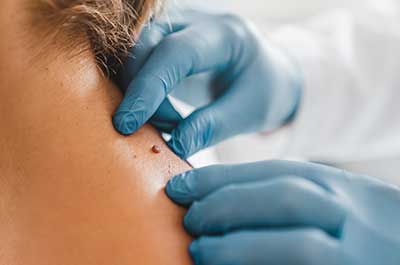You may not be concerned about getting a little sun on your face. However, that healthy glow from the sun is actually causing damage that can lead to skin cancer.
Skin cancer is the most common form of cancer, and sun exposure is the leading cause. Over time, sun exposure adds up, increasing your skin cancer risk.
“For skin cancer, prevention is key," says Samantha Tam, M.D., an otolaryngologist (ear, nose and throat specialist) at Henry Ford Health. "Be diligent about protecting yourself from the sun. Don't ignore areas on your skin that just aren't healing. The sooner the skin cancer is detected, the more likely we are able to treat it with minimal side effects."
How To Spot Skin Cancer On The Head And Neck
“While skin cancers can occur anywhere on the body, one-third develop on the head and neck,” says Dr. Tam. “Each time you head outside, your head and neck are exposed to the sun. If you spend a lot of time in the sun or live in a warm climate, your exposure is even greater.”
Anyone can get skin cancer. However, a family history of skin cancer, tanning-bed use, past sunburns or a lighter-colored complexion increases your risk. “You can reduce skin cancer risk by knowing the signs to spot it early when treatment is most effective,” says Dr. Tam.
Any of the four types of skin cancers can develop on the head and neck:
Basal cell carcinoma
In the U.S., basal cell carcinoma is the most common form of cancer. It usually occurs on the face, ears and neck. It’s slow-growing and rarely spreads to other areas of the body.
Signs of basal cell carcinoma include:
- Raised areas with a white or pink pearl color with a crater in the middle
- Flat area with a scaly appearance
Squamous cell carcinoma
Squamous cell carcinoma is the second most common cancer in the U.S. It often develops on sun-exposed skin but can occur and spread to other areas of the body.
Signs of squamous cell carcinoma are:
- Bumps with red, scaly or crusty patches
- Moles, warts or other lesions that have changed in size or color
- Scabs that won’t heal
Melanoma
Melanoma is less common but it’s the most dangerous skin cancer. It can begin on the skin of the head and neck and spread to the lymph nodes. These nodes are small kidney-shaped organs that are part of the immune system and located throughout the body. The thickness of the melanoma determines whether it’s likely to spread to the lymph nodes and other organs.
Dr. Tam recommends following the ABCDE guidelines to spot early signs of melanoma on your head and neck. Check moles or other lesions for these characteristics:
- Asymmetrical shape
- Borders that are irregular
- Color differences within the lesion
- Diameter changes (larger than a pea)
- Evolving changes in appearance over time
Merkel cell carcinoma
Merkel cell carcinoma is a rare, fast-growing skin cancer caused by a viral infection. People aged 70 and over are at increased risk.
This skin cancer first appears as a painless red or purple bump on sun-exposed skin. However, the initial bump can grow quickly, changing from something that looks like a pimple to a larger lesion.
Skin Cancer Treatment
“Left untreated, some skin cancers can spread to other areas of the body, requiring more complex care,” says Dr. Tam. “But when skin cancer is detected early, removing it can often be a cure.”
Early-stage skin cancer
Small skin cancers on the head and neck can usually be removed in the office by a dermatologist or a Mohs surgeon. Mohs surgery is a precise technique that removes the skin in thin layers. Each layer is analyzed to look for skin cancer cells. When no cancer cells remain, the procedure is over. Mohs surgery allows for removal of just the cancer, sparing healthy tissue.
Advanced skin cancer

Dermatology At Henry Ford
For larger skin cancers, your dermatologist may refer you to a head and neck surgical oncologist for a sentinel lymph node biopsy. With this test, the doctor removes a small sample of tissue from targeted lymph nodes close to the original cancer to see if the cancer has spread (metastasized).
“If skin cancer has spread to other areas of your body, you may need more intensive treatments like more extensive surgery, radiation or even immunotherapy," says Dr. Tam.
Skin Cancer Prevention
The best way to prevent skin cancer on your head and neck is to stay safe in the sun:
- Wear a broad-brimmed hat, sunglasses, sunscreen and ultraviolet (UV) protective clothing.
- Limit sun exposure between 10 a.m. and 2 p.m. when the sun’s UV rays are the strongest.
- Be aware of products and medications that may increase your sensitivity to the sun.
Dr. Tam also recommends regular skin checks if you’re at risk for skin cancer. Before getting a skin cancer screening, list any areas you want your dermatologist to examine.
“Pay attention to any skin changes on your head and neck. Ask your partner, hairdresser or barber to check your scalp for changes you can’t see,” she says. “You can take an active role in reducing your skin cancer risk.”
Reviewed by Samantha Tam, M.D., an otolaryngologist who sees patients at Henry Ford Cancer - Detroit and Henry Ford Medical Center - Fairlane.



